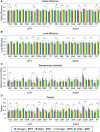Metabolic connectivity has greater predictive utility for age and cognition than functional connectivity
- PMID: 40008331
- PMCID: PMC11851278
- DOI: 10.1093/braincomms/fcaf075
Metabolic connectivity has greater predictive utility for age and cognition than functional connectivity
Abstract
Recently developed high temporal resolution functional (18F)-fluorodeoxyglucose positron emission tomography (fPET) offers promise as a method for indexing the dynamic metabolic state of the brain in vivo by directly measuring a time series of metabolism at the post-synaptic neuron. This is distinct from functional magnetic resonance imaging (fMRI) that reflects a combination of metabolic, haemodynamic and vascular components of neuronal activity. The value of using fPET to understand healthy brain ageing and cognition over fMRI is currently unclear. Here, we use simultaneous fPET/fMRI to compare metabolic and functional connectivity and test their predictive ability for ageing and cognition. Whole-brain fPET connectomes showed moderate topological similarities to fMRI connectomes in a cross-sectional comparison of 40 younger (mean age 27.9 years; range 20-42) and 46 older (mean 75.8; 60-89) adults. There were more age-related within- and between-network connectivity and graph metric differences in fPET than fMRI. fPET was also associated with performance in more cognitive domains than fMRI. These results suggest that ageing is associated with a reconfiguration of metabolic connectivity that differs from haemodynamic alterations. We conclude that metabolic connectivity has greater predictive utility for age and cognition than functional connectivity and that measuring glucodynamic changes has promise as a biomarker for age-related cognitive decline.
Keywords: ageing; cognition; fMRI; functional PET; functional connectivity.
© The Author(s) 2025. Published by Oxford University Press on behalf of the Guarantors of Brain.
Conflict of interest statement
The authors declare no conflicts of interest.
Figures








References
-
- Jamadar SD, Behler A, Deery H, Breakspear M. The metabolic costs of cognition. Trends Cogn Sci. 2025. [In Press]. 10.31219/osf.io/m5jze. - DOI - PubMed
-
- Conant JB, Cramer RD, Hastings AB, Klemperer A, Solomon AK, Vennesland B. Metabolism of lactic acid containing radioactive carboxyl carbon. J Biol Chem. 1941;137:557–566.
-
- Phelps ME, Huang SC, Hoffman EJ, Selin C, Sokoloff L, Kuhl DE. Tomographic measurement of local cerebral glucose metabolic rate in humans with (F-18)2-fluoro-2-deoxy-D-glucose: Validation of method. Ann Neurol. 1979;6(5):371–388. - PubMed
-
- Sokoloff L. Quantitative measurements of cerebral blood flow in man. Methods Med Res. 1960;8:253–261. - PubMed
LinkOut - more resources
Full Text Sources
